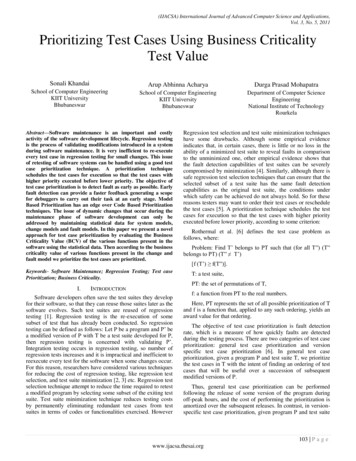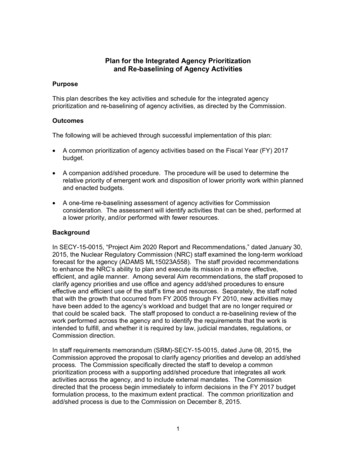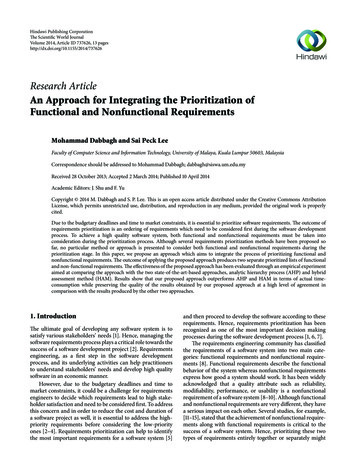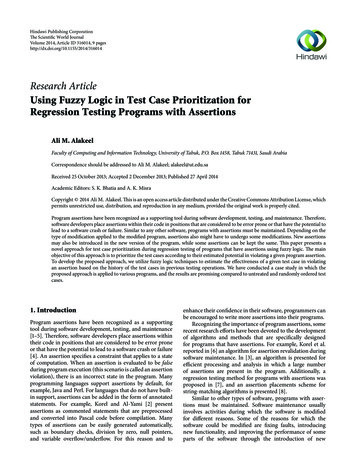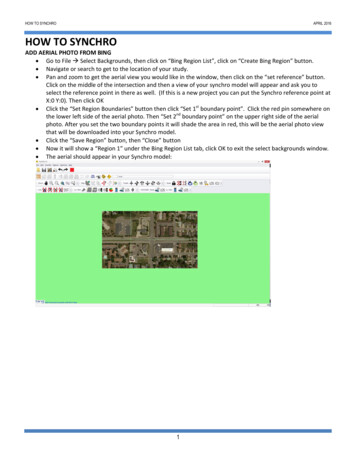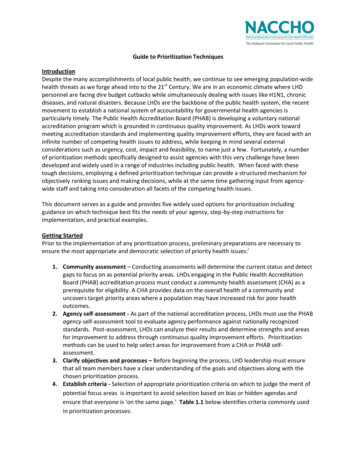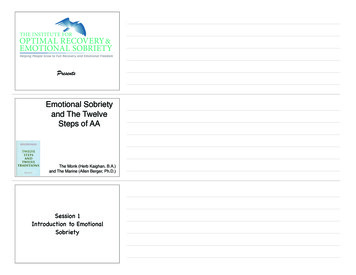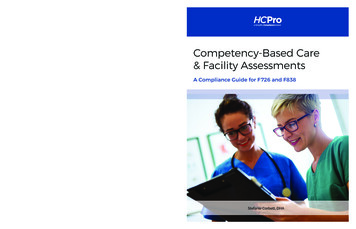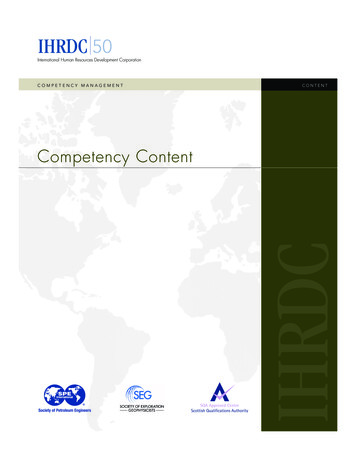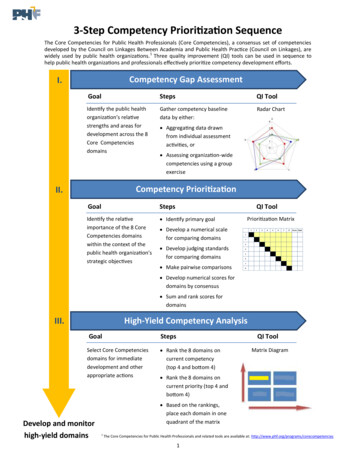
Transcription
3-Step Competency Prioritization SequenceThe Core Competencies for Public Health Professionals (Core Competencies), a consensus set of competenciesdeveloped by the Council on Linkages Between Academia and Public Health Practice (Council on Linkages), arewidely used by public health organizations.1 Three quality improvement (QI) tools can be used in sequence tohelp public health organizations and professionals effectively prioritize competency development efforts.Competency Gap AssessmentI.GoalStepsQI ToolIdentify the public healthorganization’s relativestrengths and areas fordevelopment across the 8Core CompetenciesdomainsGather competency baselinedata by either:Radar Chart Aggregating data drawnfrom individual assessmentactivities, or Assessing organization-widecompetencies using a groupexerciseCompetency PrioritizationII.GoalStepsQI ToolIdentify the relativeimportance of the 8 CoreCompetencies domainswithin the context of thepublic health organization’sstrategic objectives Identify primary goalPrioritization Matrix Develop a numerical scalefor comparing domains Develop judging standardsfor comparing domains Make pairwise comparisons Develop numerical scores fordomains by consensus Sum and rank scores fordomainsHigh-Yield Competency AnalysisIII.GoalStepsSelect Core Competenciesdomains for immediatedevelopment and otherappropriate actionsDevelop and monitorhigh-yield domainsQI Tool Rank the 8 domains oncurrent competency(top 4 and bottom 4)Matrix Diagram Rank the 8 domains oncurrent priority (top 4 andbottom 4) Based on the rankings,place each domain in onequadrant of the matrix1The Core Competencies for Public Health Professionals and related tools are available at: http://www.phf.org/programs/corecompetencies1
I.Competency Gap AssessmentGoal:Identify the public health organization’s relative strengths and areas for developmentacross the 8 Core Competencies domains. A sample follows the description of steps, and ablank radar chart template is provided on the following page.Option 1Aggregate IndividualCompetency DataSteps Option 2Estimate Organization-wideCompetenciesGather individual-level data on current competencies in the workforce in all 8 Core Competencies domains. This may be done using a competency assessment tool (self-assessment).2 Different versions of the tool are available for progressive career stages.Calculate an average score for each domain foreach individual; then calculate an average scoreacross all individuals in each domain.Plot average domain scores3 on a radar chart(example shown below). Convene a group of 8-10 individuals who arecollectively familiar with the skills and performance of a broad cross-section of the workforce.Agree on a rating scale (e.g., 0 to 4) and reachconsensus on the current competency of theworkforce in each of the 8 Core Competenciesdomains.Capture the rationale for the consensus ratingon each domain.Plot scores for each domain on a radar chart(example shown below).ProsIndividual-level is ideal for capturing specifics andvariations across the workforce. The data can begrouped by tenure, role, or other factors to assist inpinpointing areas of relative strength and opportunities for development.Ideal for making a global assessment of overall workforce needs as a snapshot in time. Can be completedby a small group of individuals during a two-hourmeeting.ConsCan be time-consuming to gather and analyze thedata. No norms exist for the assessment tool.Because group members have exposure to a limitedsample of the workforce, the data may suffer fromsampling bias.Label oneaxis for eachdomainPlot scores on eachaxis, with lowerscores plotted closerto the center of thechart2The tools were designed as self-assessments to be completed by individual public health workers; they can also be used by managers to assess competencies of their team members.Competency assessment tools provided by the Council on Linkages are available at: http://www.phf.org/competencyassessments3Optional step: Calculate and plot the range and/or standard deviation for the workforce on each domain to examine the variation in competencies across the workforce.2
I.Competency Gap Assessment (continued)Use the blank radar chart to record the competency scores for your organization.Which Core Competencies domains represent relative strengths and opportunities for potentialimprovement?3
II.Goal:Competency PrioritizationIdentify the relative importance of the 8 Core Competencies domains within the context of thepublic health organization’s strategic objectives. A sample follows the description of steps, and ablank prioritization matrix template is provided on the following page.Steps: Construct and complete a matrix in which all domains are compared to all other domains (one ata time) with the relative importance of domains evaluated according to programmatic goals. Identify decision criteria driver or goal (e.g., improved outcomes, improved efficiency,improved client satisfaction, improved financial results, improved flexibility).Develop a numerical scale to represent each judgment based on the decision criteriaselected. The scale will be used to assign values to each comparison of one domain toanother. For example: 0—no relationship, 1—equally important, 5—significantly moreimportant, 10—exceedingly more important, 1/5—significantly less important, 1/10—exceedingly less important.Develop standards for judging to make sure each domain gets a thorough evaluation.Develop numerical scores by consensus by making pairwise comparisons between alldomains (e.g., domain 1 vs. domain 2, domain 2 vs. domain 3). Let the experts decide;expertise will tend to vary from one domain to another during the exercise. Does having contribute more than in achieving the goal? Will lead toward the goal more than ?Sum and rank scores for each domain.Rank order the scores; lower ranksAssign a score to eachpairwise comparison;scores in white cells arethe inverse of scores inthe yellow cells for thesame domain pairIn yellow cells, valuesless than 1 indicatethe row’s domain isless important thanthe column’s domain11. Analytical/Assessment SkillsTotal the cell values ineach row to reachscores for each domainare the higher priorities accordingto the group’s 12.862. Policy Development/Program Planning Skills53. Communication Skills151/10115. Community Dimensions of Practice Skills1010156. Public Health Sciences Skills111/51/1017. Financial Planning and Management Skills551/101/51018. Leadership and Systems Thinking Skills51/511/5154. Cultural Competency Skills41/5Score Rank
II.Competency Prioritization (continued)Use the blank matrix below to complete the prioritization exercise.Which Core Competencies domains are most important to realizing your organization’s strategicobjectives?12345678Score Rank1. Analytical/Assessment Skills2. Policy Development/Program Planning Skills3. Communication Skills4. Cultural Competency Skills5. Community Dimensions of Practice Skills6. Public Health Sciences Skills7. Financial Planning and Management Skills8. Leadership and Systems Thinking SkillsRating Scale:This rating scale is only a sample.Scales with finer gradation canalso be used (e.g., 1/3, 1/4, 1/5,1/6); however, scales with fewergradations (such as the one tothe right) emphasize differencesbetween options and makeranking domains much easier.0—no relationship1—equally important5—significantly more important10—exceedingly more important1/5—significantly less important1/10—exceedingly less important5
III.Goal:High-Yield Competency AnalysisSelect Core Competencies domains for immediate development and other appropriate actions.A sample is provided below, and blank grid templates are provided on the following page.Steps: Using the data from Exercise I, rank the 8 domains on current competency.Higher CompetencyDomainsLower CompetencyDomains1. Cultural Competency Skills5. Public Health Sciences Skills2. Analytical/Assessment Skills6. Community Dimensions of Practice Skills3. Communication Skills7. Policy Development/Program Planning Skills4. Financial Planning and Management Skills8. Leadership and Systems Thinking SkillsUsing the data from Exercise II, rank the 8 domains on current priority for future success.Higher PriorityDomainsLower PriorityDomains1. Policy Development/Program Planning Skills5. Cultural Competency Skills2. Community Dimensions of Practice Skills6. Leadership and Systems Thinking Skills3. Financial Planning and Management Skills7. Analytical/Assessment Skills4. Communication Skills8. Public Health Sciences SkillsBased on the rankings, place each domain in one quadrant of the Matrix Diagram below.Community Dimensions of Practice SkillsPolicy Development/Program Planning SkillsPriorityfor FutureSuccessCommunication SkillsFinancial Planning and Management SkillsIIIPublic Health Sciences SkillsLeadership and Systems Thinking SkillsAnalytical/Assessment SkillsCultural Competency SkillsIVIIICurrentCompetencyI DEVELOP: Higher priority areas where competency is relatively lowII LEVERAGE: Higher priority areas where competency is relatively highIII MAINTAIN: Lower priority areas where competency is relatively highIV DE-EMPHASIZE: Lower priority areas where competency is relatively low6
III.High-Yield Competency Analysis (continued)Use the blank tables below to identify high-yield Core Competencies domains.Which Core Competencies domains shall we prioritize for workforce development in theshort-term?Steps: Using the data from Exercise I, rank the 8 domains on current competency.Higher CompetencyDomainsLower CompetencyDomainsUsing the data from Exercise II, rank the 8 domains on current priority for future success.Higher PriorityDomainsLower PriorityDomainsBased on the rankings, place each domain in one quadrant of the Matrix Diagram below.Priorityfor FutureSuccessIIIIVIIICurrentCompetencyI DEVELOP: Higher priority areas where competency is relatively lowII LEVERAGE: Higher priority areas where competency is relatively highIII MAINTAIN: Lower priority areas where competency is relatively highIV DE-EMPHASIZE: Lower priority areas where competency is relatively low7
II. Competency Prioritization Identify the relative importance of the 8 ore ompetencies domains within the context of the public health organization's strategic objectives. A sample follows the description of steps, and a blank prioritization matrix template is provided on the following page. Goal: Steps:
